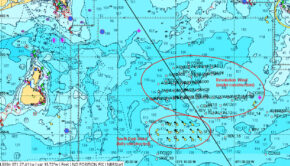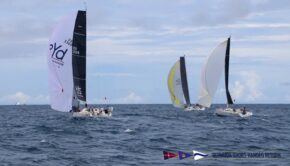The Hard Charging Results
Published on February 7th, 2024
Peter Becker, who had previously reported about the upgrades to the batteries and charging system on a J/105 for offshore racing, provides the results of these upgrades:
First a quick recap of how all this started. In 2021, I sailed an amazing race called the Bermuda 1-2. This would be my first time sailing an ocean race solo, and I loved it! And this also would be the first time racing our J/105 on a true ocean course.
One thing I discovered is short-handed sailing is enticing, so much so that with the help of the New York Yacht Club, the Royal Bermuda Yacht Club, and the Cruising Club of America, a new race was created, the Bermuda Short-Handed Return, a single- and double-handed race back to Newport.
Part 1 of the story discussed the significant challenges we had with charging during the 2021 Bermuda 1-2 and our plan to fix the charging issues in preparation for future ocean racing back and forth between Newport, RI and Bermuda. The essence of the crazy and frustrating problem we had to fix was needing to charge Eight Hours of Charging per Day! We now know the solution to Hard-to-Charge is satisfying and highly effective.
The Plan – change out the two 150 Ah AGM batteries for two 114 Ah Lithium Iron Phosphate (LiFePO4) batteries. The new LiFePO4 batteries are configured as a dedicated house bank and a small (group 24) lead-acid battery would be dedicated to engine starting.
The complement to the LiFePO4 batteries is the replacement of the internally regulated Hitachi 55-amp alternator with an externally regulated 140-amp Elextromaax alternator driven by a new serpentine belt system.
The Execution – given the simplicity of the electrical system on the boat, we designed and installed the system ourselves using expert guidance from the manufacturer, Elextromaax, and our good friends Jonathan and Jeff Udell of Custom Offshore. This turned out to be a good plan because of the quality of the advice we were given and the patience of the advisors.
It also helped that I have a degree in marine engineering and know one end of the screwdriver from the other. Our recommendation for anyone looking to make the upgrade to LiFePO4 batteries is to strongly consider using a highly qualified electrical systems installer, and certainly, if you have a more complicated electrical system.
Lots of Things Learned During the Installation:
• It is really important to read the manuals several times over! Also, don’t be a typical guy and not ask for help!
• Note that not all installation manuals agree with each other which creates questions, and the manuals are often not very clear in their wording.
• Designing and laying out the system takes time, and it may take many attempts before you fully understand the details of the system and are confident you have got it right.
• There are some unexpected new things such as fast blow fuses, what are they, why do I need them, and how can I source them, they come in different sizes, which is not clear when ordering the fuse and the fuse holders separately.
• Most of the battery cables need to be increased in size; do not overlook this point.
• When connecting multiple batteries in parallel, cables must be of equal length.
• There are a lot of wire runs and the “real estate” gets tight. You will need to find room for all the fuses and terminal blocks, DC/DC converter, regulator, and all the associated wire runs. Planning is paramount to success!
• Crimping large-size battery cables is not straightforward,. First, you need to get the correct lugs and crimping tool. It turns out that most tools on the market are not correctly sized or properly marked. Rod Collins has some great advice on tools and making cables at marinehowto.com.
• Wire runs need to be tidy and to do this takes planning and patience.
• Label, label, label
Operational Lessons:
• A must-have is a battery monitor to indicate the state of charge (SoC). Unlike lead-acid batteries where the voltage drops as the battery is depleted, LiFePO4 batteries have a steady voltage right down to a very low SoC. With Lead-acid the voltage is a proxy for the SoC whereas with LiFePO4 you need a monitor to understand the SoC of the battery. We installed a Victron Energy Battery Monitor BMV-712. Accurately knowing the SoC and understanding the fact that LiFePO4 batteries can be drawn way down and charged back up quickly has removed almost all of the mental stress we used to have with keeping the AGM batteries charged and at voltage.
• With a low-horsepower engine like the Yanmar 2GM20 we have, it is important to have manual control of the alternator field current as a way to limit the HP being taken by the alternator. Without the alternator field current control, you may not have sufficient HP available to the propeller when needed.
• The Eletromaax regulator is connected by Wi-Fi to the ship’s laptop and iPhones. This connection provides lots of interesting information and allows for software-based manual control over the alternator field current. There is also a manual toggle switch in the cockpit to limit the field current to 50%.
• A dedicated engine start battery is by far the best way to go. It removes the worry that somehow you lost your ability to start the engine because someone inadvertently depleted both the A and B battery banks, a risk with the traditional system. Charging the starting battery from the house bank seems to be a foolproof setup. We choose the Balmar Digital Duo Charge DDC-12/24 which provides up to 30 amps of regulated charging current to the starting battery when it senses charging voltage from the house bank. Victron makes a good DC/DC charger as well.
• We also installed a BEP dual bank control battery switch which is functionally the same as having three switches. Unlike the typical A-B-All selector battery switches the dual bank switch allows for energizing separately the house and the engine start loads as well as the ability for paralleling the banks. One benefit of the switch setup is it isolates sensitive electronics from starter motor-induced voltage drops.
The Important Details I Did Not Fully Expect:
• The importance of ensuring that the battery cables are of equal length.
• The subtleties of the wiring batteries in parallel to keep them in balance.
• The sheer amount of bogus information that is out there on YouTube regarding LiFePO4 batteries.
• The complications of managing the space available for the installation.
The Big and Important Victories:
• What had been eight hours per day of charging with the old system is now reduced to only one hour per day! This is amazing!
• We are experiencing more than 75% savings in fuel burned for charging. For a five-day race to Bermuda, that is at least nine gallons that is no longer needed to be carried and more than 70 pounds of weight savings.
• I now experience a huge reduction in the stress associated with managing the batteries and keeping the electronic system running. This leaves me with a bigger smile and more time to focus on the racing.
• With a dedicated starting battery, we eliminate the voltage drop on the house circuit when starting the engine which is typical of the “old” system. That voltage drop used to momentarily knock out the electronics which was problematic and irritating at the very least.
• It may seem like a simple thing, but the serpentine belt that is needed to deliver the higher horsepower to the bigger alternator would have been a desirable upgrade, even for driving the old original 55-amp Alternator. The serpentine belt holds its tension and does not slip therefore eliminating the black belt dust that used to fill my engine box.
Fuel Day Tank:
An associated project was the design and installation of a 3-gallon day tank. A problem exists with the J/105 fuel tank due to the tank’s triangular transverse section and the fact that the fuel pickup tube is located at the inboard deep side of the tank.
All is fine when the boat is on an even keel, but when healed on starboard tack with anything less than a ¾ tank, the engine will pick up air as the fuel sloshes away from the pickup tube. This means either you can’t charge the batteries on starboard tack, or you need to bring a lot more fuel in jugs to allow refilling the tank to maintain the tank at least ¾ full.
Our solution was to weld up an aluminum day tank sized to fit under the bunk just aft of the main fuel tank. An electric fuel pump is located inline between the two tanks to move fuel from the large tank to the day tank.
In normal operation, the electric fuel pump is off, passively allowing the engine to draw fuel from the main tank. The fuel return line passes through the day tank on its way back to the main tank and is fitted with a one-way check valve. That way air picked up from the main tank will be caught at the day tank and vented back to the main tank without being drawn to the engine.
The day tank has been a game changer and allows us to sail with very little fuel on board, even for shorter-duration races without the fear of constantly needing to vent the fuel line to restart the engine. There additionally is increased safety associated with having a reliable engine.
Why does all this matter?
While we know that all boats benefit from good batteries, charging equipment, and battery management systems, it is particularly important for the short-handed long-distance ocean sailor, who by definition is short on resources and not tolerant of unnecessary distractions such as managing battery voltage and fuel levels.
What I have learned when solo- and double-handing is the critical importance of self-care and the elimination of distractions. The improvements discussed have made a huge change in reducing the stressors while increasing the joy of offshore short-handed sailing.
And the best part is that since the creation of the Bermuda Short-Handed Return, we can now sail short-handed, in high-quality races, to and from Bermuda, every year! I’m excited to be preparing for double-handed sailing in the 2024 Newport Bermuda Race and the Bermuda Short-Handed Return.
Be happy! Change hard-to-charge into hard-charging.
Peter Becker, a cofounder of the Young American Sailing Academy, is a solo sailor and the NY station rear commodore of the CCA, a member of NYYC and American YC, an early adaptor to the foiling Moth, a Transoceanic sailor on IMOCA 60, and now an avid short-handed sailor.









 We’ll keep your information safe.
We’ll keep your information safe.